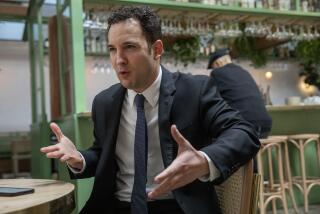The Winning Politico Is Usually Head and Shoulders Above the Rest
In trying to predict the outcome of a presidential election, most pundits concern themselves with the contenders’ stands on the issues. Personally, I pay more attention to what the candidates look like.
Generally speaking, the tallest and most attractive candidate wins. Social psychologists have documented that in the vast majority of elections, whether presidential or otherwise, the office seeker with the greatest height and handsomest face has come out ahead.
Only twice in this century have the shorter of the two presidential finalists defeated their taller opponents. The first was when Richard Nixon defeated George McGovern in 1968, the second when Jimmy Carter won against Gerald Ford eight years later. These elections are also among the small minority in which the less handsome aspirant made it to the White House.
Taller candidates usually win because, in most peoples’ minds, height signifies power and ability. In business as well as politics, taller applicants have an easier time getting hired into leadership and sales jobs. According to several studies, their starting salaries also tend to be higher. Employers believe that a tall person is better able to take charge of situations.
Like height, good looks also prove to be broadly beneficial. Attractive people are generally assumed to be more intelligent, successful, healthy, happy, sane, poised, trustworthy and powerful than are average or unattractive folks. As a result, employers consider them to be more valuable. A national survey conducted a few years ago discovered that the average income of attractive men and women is 11% higher than that of average-looking people, and 19% greater than what homely people make.
Favorable expectations about the tall and attractive are nothing more than stereotypes, of course, no more likely to be accurate than those held about members of ethnic minority groups. Unlike racial prejudices, though, which receive a great deal of public scrutiny, biases about attractiveness remain generally undiscussed, and thus tacitly accepted. One consequence is that the best-looking candidates hold a subliminal advantage.
On the other hand, not all of our collective presumptions about good-looking people are positive. In fact, one widely held negative stereotype may prove pivotal in this year’s presidential race. Social psychologists have found that attractive men and women are widely assumed to possess overactive sex drives, which draw them unavoidably into promiscuity. (Conversely, the unattractive are thought to be naturally dull and sexually repressed.)
Now that the specter of AIDS hangs over sex, and liberals and conservatives alike regard monogamy as next to godliness, the political advantages of attractiveness may have become less reliable than in the past.
I wonder if Gary Hart’s good looks are not a major reason he has been singled out for sexual scrutiny. Clearly he didn’t do himself a favor by posing with Donna Rice on his lap, but would the press have been as interested in a similar picture of, say, Paul Simon? Such a photo might have surprised or even amused us, rather than confirmed our worst fears.
Until now the knee-jerk reaction on Election Day has been to vote for the candidate with the most commanding physical presence. And since so many Americans vote with their knees rather than their heads, smart money has been on the tallest, most attractive aspirant.
This year political matters have become more complicated. Height is still a plus, but attractiveness is another matter. Based on looks alone, the candidate with the best chance of winning could be tall but average-looking. If one party nominates such a candidate and the other puts forward a short and ugly opponent, I’m ready to place a sizable bet with the odds-makers in Las Vegas.
More to Read
Get the L.A. Times Politics newsletter
Deeply reported insights into legislation, politics and policy from Sacramento, Washington and beyond. In your inbox three times per week.
You may occasionally receive promotional content from the Los Angeles Times.









